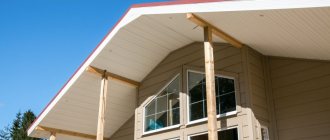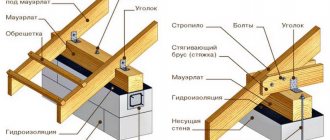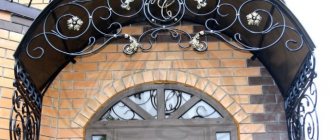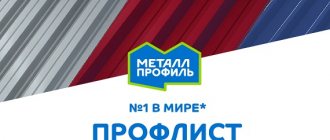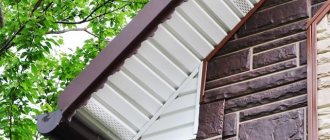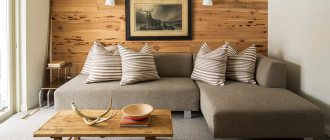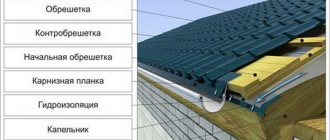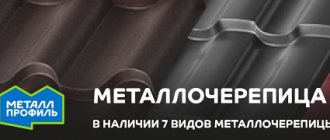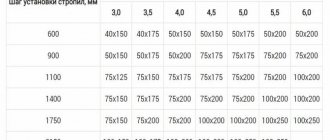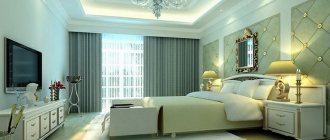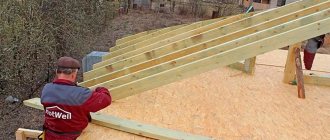During the construction of a house, the highest demands are placed on the appearance of the roof: to protect the walls and under-roof space from moisture and dampness, as well as to give the entire building a flawless and finished look. And for this, the roof must look beautiful from all sides, even from the one that is under the eaves. After all, this is where the gaze is directed when someone stands near the house.
It is for this purpose that there is a lining of roof overhangs made of a variety of materials: vinyl, metal and even wood. Special products for this purpose are called soffits, which also provide ventilation to the entire under-roof space, which is so necessary.
Roof overhang lining device
Let's first figure out what roof eaves lining is.
The roof eaves lining has the following design options:
By the way, soffits are not necessary - in most cases, solid or partially perforated panels are sufficient:
Seam roofing
This option will allow you to get the job done inexpensively. The coating in this case is made of thin metal sheets. Their lengthwise connection is made by bending the folds. This coating material is not suitable for DIY work, since it requires certain skills and knowledge.
It is not recommended to do the installation of a seam roof yourself.
When deciding what is the best way to cover the roof of a house, you should pay attention to simpler types. This option is more suitable for a professional team that will do the work quickly and efficiently.
Types of spotlights for different tasks
By and large, soffits are the same siding, only for decorating the ceiling. Hence the name, because “soffit” means “ceiling” in Italian.
Soffits are produced in a variety of types. They are:
- double and triple;
- solid and perforated.
Perforated soffits provide excellent ventilation and air flow into the under-roof space.
At the same time, triple ones can be combined: solid at the edges and perforated in the center. Completely solid ones are often used for lining gable overhangs that do not need ventilation:
And, more as an exception, an additional ventilation hole is cut in solid soffits, often after installation:
By the way, GrandLine presents unusual soffits (GL Estetic), in which the perforation is hidden. It is applied to the stiffening ribs, so it is not visible. This geometry is called Ω-geometry, which also masks the joint of the soffit itself.
What materials can be used and their performance characteristics
As mentioned earlier, hemming can be done using various materials. Which one to choose depends on individual wishes, the characteristics of a particular building, the materials from which the house is built, etc.
The main criterion for choosing a material, which must be taken into account, is the strength and reliability of protecting the eaves areas from the negative effects of precipitation. In addition, the lining of the overhangs should provide good ventilation
Also, do not forget about the performance characteristics of the material. It must be durable and maintain its characteristics throughout its entire service life. Let's take a closer look at each of the materials and try to figure out which one is better to choose.
Choice of material: wood, vinyl or steel
In fact, soffits in their design and production method are not much different from siding. As well as in terms of strength, because soffits also need to have mechanical strength to impacts and strong winds.
Soffits made of plastic or vinyl are relatively fireproof, very light and do not rot, are easy to process and can take almost any shape. Thanks to this, soffits cover complex architectural elements.
Vinyl soffits go well with popular vinyl siding, are flexible, durable and lightweight. With a thickness of 0.4 cm, they weigh only 1.16 kg/m2.
Because The spotlights are always in the shade; there is no need to worry that they will fade in the sun. PVC is also good because it is not destroyed by mold or mildew, does not need painting and can withstand frost of -50°C and heat of +60°C. By the way, vinyl soffits today are often made not only to match the color of the roof or facade, but also to imitate natural wood.
Modern metal soffits are manufactured using special equipment by rolling. They are made from galvanized steel with a polymer coating such as pural, plastisol, polyester or polyvinylidene fluoride. In fact, their price directly depends on the coverage. They are durable, reliable and practical.
Polyester as a coating for steel soffits is good for color fastness and ductility, and plastisol is resistant to mechanical stress. Pural is more resistant to ultraviolet radiation and temperature changes, and is most suitable for use outdoors.
Typically, manufacturers offer to purchase a whole set of necessary roofing materials at once, so that in the end the entire roof has a complete look, where all the elements are in perfect harmony with each other in shape, color, and type of coating.
Flexible and lightweight aluminum soffits are made from thin (0.5 mm) aluminum strip. Such soffits are highly resistant to corrosion, do not emit an unpleasant odor under the steaming rays of the sun, and are absolutely environmentally friendly.
The decorative coating adheres well to such material, even if it has to endure significant temperature changes. Thanks to this, aluminum soffits are suitable for any climate.
Aluminum soffits are practically not subject to corrosion, are not flammable, and are little susceptible to thermal expansion, fading and mechanical damage. However, this is the most expensive type of spotlights.
In this regard, wooden soffits . True, from time to time they will have to be restored to their original form, treated with antiseptics and tinted.
There is also such an interesting type of spotlights as planken . Essentially, this is the same plastic, only made in a wooden style. Moreover, both beveled and straight planken look good. In this case, under-roof ventilation is provided by a ventilation gap.
But copper soffits are considered not only the most durable material, but also the most unpretentious, aesthetically pleasing and naturally protected from environmental influences. Copper products form a natural anti-corrosion coating, thanks to which the service life of such soffits can reach 150 years!
the Soffitto filing system is popular . These are copper soffits, the color of which changes over two to three years from golden to dark brown, and then to matte black. And finally, the last stage of oxidation is a greenish patina.
Fiber cement siding is also becoming popular , which is quite durable and attractive with the beautiful texture of cedar wood. Such a binder is made from a cement-sand base and fibers - synthetic or natural.
The service life of such material reaches 50 years; there is no linear expansion due to temperature changes. In addition, fiber-reinforced concrete siding, unlike ordinary wood, does not rot, is not attractive to insects and is not afraid of moisture. And such a binder is processed and attached in the same way as a wooden one.
If the filing is solid, then special slots 0.5 cm thick are made in the panels. In this case, you need to install a mosquito or metal mesh on the inside. It is important that all components are made of aluminum. This includes external and internal corners, J-profiles and connecting strips.
Also suitable for filing overhangs are profiled sheets with a thickness of 0.45 mm or more made of galvanized steel or polymer-coated steel. They differ from other analogues in good strength and rigidity and a large selection of colors.
If you decide to make overhangs from such a material, then cut the corrugated sheet into strips of the same size and carefully paint over the sections so that corrosion does not spread, but the paint is not noticeable on the main surface of the sheet.
Roof tiles
Natural ceramic tiles are one of the popular types of roofing for a country house. It is made from special clay using the tape or stamping method with further firing.
Roof tiles
Advantages of tiles:
- Low thermal conductivity;
- Frost resistance;
- The roof has high sound insulation;
- Good maintainability;
- Waterproofing;
- Inertness to biological and chemical influences;
- UV resistance.
Tile roof
The disadvantages of this material include:
- Its heavy weight;
- Fragility.
The high cost can also be considered a disadvantage of tiles - from 500 rubles per m²
Types of profiles for filing cornice and gable overhangs
Let's move on to the process of installing spotlights. They do not perform a particularly important constructive function, but you still have to show skill and accuracy here.
The fact is that if you make mistakes when filing the cornice, then it will at least look ridiculous, and in the worst case, birds can easily penetrate into the under-roof space and create problems.
Why is the cornice hemmed?
- After laying the roofing material, part of the rafters and other layers of the “roofing cake” are visible from the bottom of the ends. This does not look aesthetically pleasing - the lining of the overhangs improves the roof, covering all the internal parts, and gives a complete look to the entire structure.
- In addition to the decorative function, hemming the eaves protects the roofing system from damage due to strong winds.
- Another important task is solved—proper under-roof ventilation is ensured, which eliminates the appearance of condensation, mildew and mold. Accordingly, the service life of the structure increases.
Installation technology
The roof on the gable side is sheathed around the perimeter with a J-profile or a special profile for the internal corner.
The installation rules here are the same as for vertical elements, where the top fastener is mounted to the upper edge of the nail hole, and all subsequent ones are mounted in their center.
Installation of perforated vinyl sheathing
Vinyl soffits are especially valuable because they are suitable for hard-to-reach areas. Their installation does not require special equipment, special knowledge or skills.
You just need to study the instructions from the manufacturer and our master classes:
So, first of all, two planks are mounted to the gable or eaves overhang along its entire length. Next follow the instructions:
- Step 1. Screw the J-slot to the first from the bottom side.
- Step 2. Next, the soffits are cut along the length of the overhang.
- Step 3. The J-profile is inserted into the corner and secured with self-tapping screws.
- Step 4. Cut out the edge of the soffits closest to the profile and insert.
- Step 5. Now we move on to facing the wind board.
- Step 6. Fasten this cladding together into a lock.
- Step 7. Secure all the planks with self-tapping screws and close the corner end-to-end.
Here is a wonderful master class on installing vinyl soffits with hidden perforations:
Installation of continuous metal overhang lining
To fix a metal soffit to the wall, you must first attach a J-shaped profile along the wall.
Using a building level, make marks on the wall that will run parallel to the bottom edge of the cornice. Attach the receiving profiles to them. Next, measure the distance between the gutters and profiles and subtract 6 mm to take into account possible expansion and contraction of the material. Our photo instructions will tell you what exactly you need to do:
To bring the upper edge of the J-chamfer under the finishing strip, it is necessary to cut special “burrs” into it. You can easily cope with this task on your own, especially if you use tools special for this purpose.
Thus, Freund 360020 and Malko NHP1R cutters easily punch slot-shaped holes of 3x15 mm and 4x19 mm. One edge of the soffit must be inserted into the groove, the other must be screwed to the second of the planks. Place everything in place and secure each panel in the center of the hole.
Next, cover the face board with a J-bevel. For a metal soffit, the width of the sheets must strictly correspond to the distance between the J-chamfer and the J-profile, you just need to subtract 6 mm for thermal expansion and, if the overhang width is more than 90 cm, then on both sides at once. Install soffit sheets between the J-bevel and the J-profile.
Here is an example of filing with metal soffits of complex shape:
Finishing the roof overhang
The junction of the soffit with the second strip is covered with a front strip. This is necessary to give the end edge a finished look:
Cut the strip to the desired width and bend the edge. Using a special bend and cutters, form the finishing strip.
In our case, the size of the frontal board is noticeably larger than the size of the J-chamfer, and therefore the installation should be carried out on the frontal board through two J-profiles or an external corner.
A light-colored soffit is used here, and this is correct - dark ones are not recommended in this case. Finally, secure the finishing strip.
Installation of wooden frame
The roof can be hemmed either parallel or perpendicular to the overhang. The only thing, keep in mind that with the parallel method all the irregularities will be noticeable, but hemming with short bars from the edge of the roof to the wall hides all the imperfections well.
If there is no frontal board as such, then the soffit must be secured between two J-profiles placed on the roof overhang and on the wall:
In practice, installing a wooden frame looks like this:
Have you chosen the right option for yourself? Glad we could help!
Frame finishing
All the materials listed above - lining, wood, corrugated sheets - are used for finishing overhangs. Its installation does not require any special skills. The main thing is correct calculations and the use of high-quality fasteners.
Hemming along the rafters using boards
If the roof overhang is hemmed along the rafters, then you need to follow the scheme:
- Align the ends of the rafters and use a cord to check.
- Install the sheathing as described above.
- Calculate the required number of boards to get a whole number.
- The boards are attached to the sheathing using self-tapping screws.
The boards can be positioned parallel or perpendicular to the wall. With a parallel arrangement, all surface irregularities are better visible. With the perpendicular method, scraps of boards are used. They are shorter and at the same time help to hide all minor defects.
Be sure to make ventilation holes in the boards so that condensation does not accumulate under the roof.
Corrugated sheet
It is advantageous to cover pitched roofs with corrugated sheets. This material is similar in properties to metal tiles, but is cheaper. These types of material may have different markings. Corrugated sheeting marked N or NS is intended for the coating . Sheets marked C are intended for vertical structures; it is not possible to make a roof from them. The profile brand (numerical designation) is selected depending on the load and pitch of the rafters.
To cover the roof, you should choose a profiled sheet of grade N or NS
Installation
The coating is intended for roofing with a slope of at least 10 degrees. The overlap during installation is assigned depending on the profile parameters. Usually the overlap made is 20 cm. If the slope is less than 20 degrees, the joints should be additionally protected from moisture with sealant.
The sheets are fastened using self-tapping screws. You will need approximately 8 pieces per square meter. It is permissible to lay the material on top of an old roof made of rolled materials.
Most often, corrugated sheets are used for outbuildings and industrial buildings. But now there are many colors that will fit perfectly into the facade of a residential building.
Advantages and disadvantages
Are you choosing which material is best for a wooden house? It is not recommended to use heavy types here. Therefore, the decision of how to cover the roof of a house in favor of a profiled sheet will be beneficial. Also perfect for buildings made of brick or concrete.
Construction of a roof pie made of corrugated sheets
The advantages include:
- ease of installation;
- good bending strength under mechanical stress and loads;
- service life like metal tiles;
- low cost.
The disadvantage is high noise . Read more about installing a roof made of corrugated sheets.
Ondulin
Ondulin roofing is a profitable solution. It is possible to cover a building with such material without significant material costs. The second name for onudlin is Euroslate. The sheets are made from cellulose fibers and impregnated with bitumen with polymer additives. At the end, the material is painted in two layers of heat-resistant paint, thanks to which the sheets acquire a neat and attractive appearance.
Installing a roof made of Euro slate is an economical option for roof construction or repair
Installation
Ondulin roof covering of a country house with a slope slope from 6° to 15° requires the installation of a continuous sheathing . You can use a regular edged board (grade 3 wood) or moisture-resistant plywood. If the slope is more than 15°, then you can get by with a sparse base.
The overlap of the sheets should be good - at least 30 cm. Special nails are provided for fastening.
Advantages and disadvantages
When deciding which material is best for a canopy, bathhouse or garage, you can confidently choose ondulin. It is also suitable for a private home. But when choosing, it is worth considering that the service life of Euro slate is up to 40 years, but the paint will fade earlier. The benefits include:
- waterproofing indicators;
- environmental friendliness;
- good load resistance;
- there will be no problems due to noise;
- ease of processing and cutting;
- very light weight;
- budget.
The main disadvantages of the coating include fading of paint and flammability.
The disadvantages of the material are quite significant, so it is worth considering whether you need to cover your house with such material. Minuses:
- flammability;
- fading of paint;
- softening of the material in sunny weather in summer (not recommended for steep slopes);
- moss growing in dark places.
